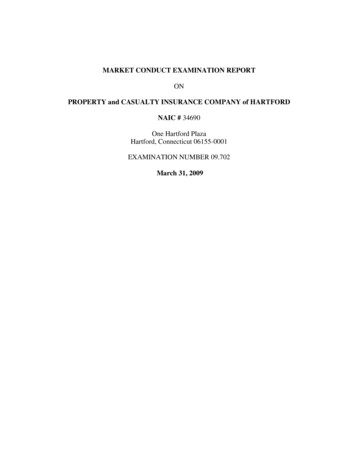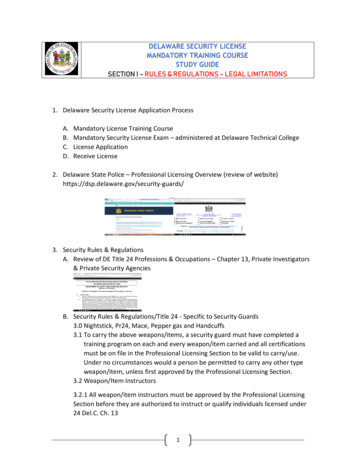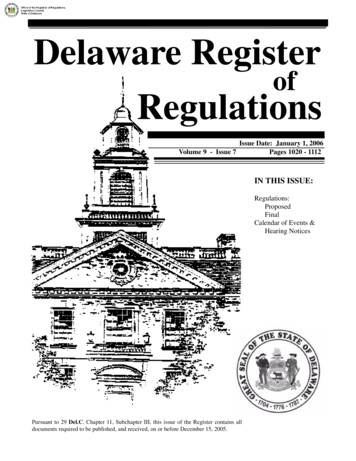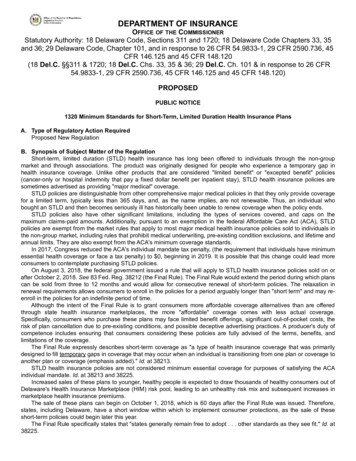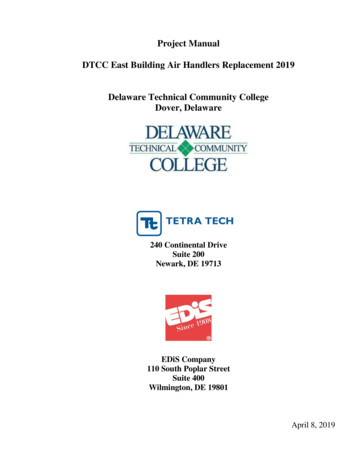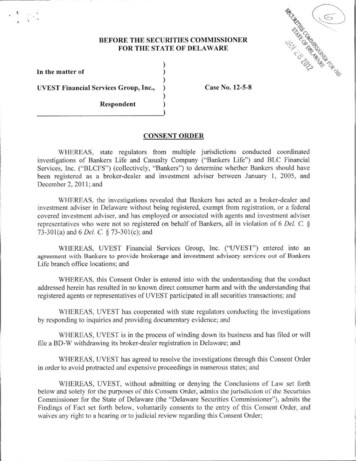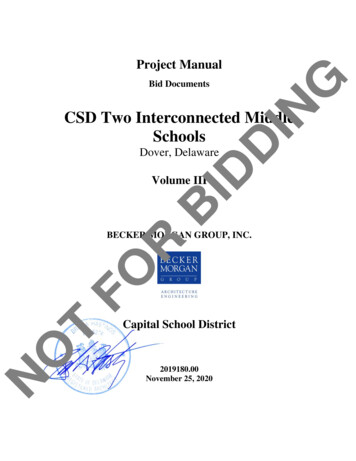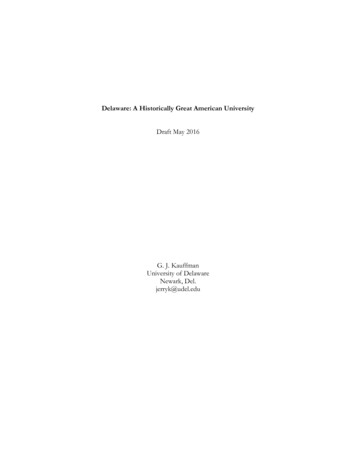
Transcription
Delaware: A Historically Great American UniversityDraft May 2016G. J. KauffmanUniversity of DelawareNewark, Del.jerryk@udel.edu0
Delaware: A Historically Great American UniversityHistoric LegacyAs one of just two land grant institutions with colonial roots that predates all but two Ivy League schools,Delaware is a historically great American university. The University of Delaware traces its genesis to theNewark Academy (est. 1743) founded three years before the College of New Jersey (Princeton), elevenyears before Kings College (Columbia University), and twelve years before the Academy of Philadelphia(University of Pennsylvania). During the First Great Awakening when congregations pushed for emergingbeliefs in science, democracy, and the free press; the Presbyterian Synod appointed Francis Allison asmaster of the Newark Academy, a school he founded in 1743 in New London, Pennsylvania. Nine yearslater, Benjamin Franklin recruited Reverend Allison to be rector and later vice provost of the Academy ofPhiladelphia, a school that became the University of Pennsylvania. The President of Yale called Allison“the greatest classical scholar in America especially in Greek.”In 1769, two years after the Academy moved a few miles south to Newark in the three lower counties ofPennsylvania, Lieutenant Governor John Penn of Pennsylvania signed the Newark Academy charter whichwas later joined with the charter of New Ark College in 1833. Four students of Francis Allison andNewark Academy signed the Declaration of Independence in 1776 - Thomas McKean and George Readfrom Delaware and Benjamin Rush and James Smith from Pennsylvania. John Maclean, the tenthPresident of Princeton, wrote that the Newark Academy was a school where the course of work was betterthan or comparable to the College of New Jersey (Princeton) and equal to the curriculum delivered byHarvard and Yale (Ryden 1935).The historic British march from Chesapeake Bay through the Newark Academy to the Battle of theBrandywine was memorable to the residents of the “Athens of Delaware.” On September 8, 1777, fivedays after Delaware’s only Revolutionary War battle at Cooch’s Bridge on the Christina River near IronHill, the British broke camp by the “light of a remarkable borealis”. As Edward Cooch (1940) wrote, “atquarter past seven they (the British) passed through Newark north on Academy Street, east on MainStreet at the Newark Academy, north on Chapel Street, crossing the White Clay Creek into Mill CreekHundred.” Elliott Hall on 26 East Main Street, now a University of Delaware building, is the onlyremaining structure in Newark that stood in 1777. When the British marched past the Academy Buildingon Main Street in Newark, cobblers in the shoe factory there fired with no casualties. The NewarkAcademy Trustees sent their funds to Wilmington but Delaware President Thomas McKean wrote toGeneral Washington that the British seized these assets from a ship anchored in the Delaware River.New Ark College opened as a degree-granting institution in 1834 and was renamed Delaware College in1843. Abraham Lincoln signed the Morrill Land-Grant Act on July 2, 1862 which sold 30,000 acres ofFederal land per state to create a system of land grant colleges to teach agriculture and the mechanical arts(engineering) to each state’s citizens. Delaware College closed during the Civil War but reopened in 1870as one of just 36 land grant colleges in the United States. In 1887, Grover Cleveland signed the Hatch Actthat provided Federal grant funds to build agricultural experiment stations at land grant colleges likeDelaware. In 1914, Woodrow Wilson signed the Smith-Lever Act that dedicated federal funding tocooperative extensions at land-grant schools to translate research and instruction to the citizens throughpublic service. In 2014, the University of Delaware celebrated the 100-year anniversary of the 1914 SmithLever Act that authorized the Cooperative Extension System. In 2014 UD also celebrated the centennialof the Women's College that opened in 1914 with 58 students and was later joined with the men’s collegein 1921 to become the University of Delaware.1
Elite InstitutionDelaware is unique as an elite institution of higher learning. The University of Delaware is thought to beone of just three privately chartered land grant institutions in America, the others are Cornell and MIT.Delaware is often referred to as a “Public Ivy” along with institutions such as Vermont, Penn State,Rutgers, College of William and Mary, and Virginia. In 2014, the University of Delaware was ranked asone of America’s premier research universities by U.S. News and World Report (75th of 201 NationalUniversities), Forbes (126th of 650 Colleges) and Academic Ranking of World Universities (151-200 of 500Research Universities). A 2015 report by the Council of State Governments and Elsevier publishers houseconcluded Delaware had the second highest rate of peer reviewed publications in the nation (afterMassachusetts) at 11.4 publications per million dollars in R&D funding. The mascot of the University ofDelaware is the state bird, the "Fightin' Blue Hen" named after the tenacious Delaware Continentalregiments who fought with George Washington against the British at Long Island, Trenton, and Princeton.ObjectiveThis white paper examines the University of Delaware as a historically great institution of higher learningand seeks to identify Delaware’s current and future place among the very finest universities in America.MethodsPrimarily organized for athletics, intercollegiate conferences and associations also provide academic andresearch benefits through membership in consortiums such as the Committee on InstitutionalCooperation (Big Ten), Ivy League, and Colonial Academic Alliance (CAA). Here we compare Delawareto our peer institutions organized by the following intercollegiate conferences and associations based onhistoric, economic, and academic metrics: Colonial Athletic AssociationIvy LeagueBig TenPatriot LeagueAtlantic Coast ConferenceEastern Eight (potential)Historic Year established when the institution or its precursor received its first charter Signers of Declaration of Independence who were educated by or affiliated with the institution.Economic Annual operating budget for FY14 in billion Endowment in 2014 in billionAcademic Undergraduate and graduate enrollment in 2014 Rank among institutions according to U.S. News and World Report Number of Nobel Prize winners plus members of National Academy of Science Number of Ph.D.’s per capita ranked by state where the institution is situated2
Colonial Athletic AssociationDelaware competes in the Colonial Athletic Association, a league that was formerly Virginia-centric butthrough reorganization now stretches from North Carolina to Boston. Of all the CAA schools, Delawarehas most in common with William and Mary. Both are state supported and share colonial roots, W&M isthe second oldest college in America. William and Mary educated five signers of the Declaration ofIndependence including Thomas Jefferson while Delaware its head master during the colonial era educatedfour. Delaware’s budget and endowment compares with or exceeds all of the CAA schools. Delaware isthe third highest ranked institution in the CAA (No. 75) after W&M (No. 32) and Northeastern (No. 49).Delaware is the only school with Nobel Prize and National Academy of Science members (4), William andMary has one. Delaware is situated in a state that ranks 3rd highest in Ph.D.s per capita while Northeasternis located in Massachusetts (2nd highest). Along with William and Mary and Northeastern, Delawaresurpasses many of its CAA peers based on these metrics.Table 1. Colonial Athletic Conference metricsCollege CharlestonDrexelHofstraJames wsonUNC WilmingtonWilliam & egeEst.Budget( B)Endowment( B)Enrollment(2013)Rank(US News)Nobel NAS3Signersof DI000000054
Figure 1. Colonial Athletic Conference metrics4
Ivy LeagueHistoric Delaware has extensive Ivy League ties. The University of Delaware traces its colonial roots to1743 and the Newark Academy founded by the Presbyterians several years before the Synod founded theprecursors of the Ivy League institutions of Princeton (1746), Columbia (1754), and Pennsylvania (1755).The tenth president of Princeton favorably compared the curriculum of the Newark Academy toPrinceton (nee College of New Jersey), Yale, and Harvard. In 1752, Benjamin Franklin recruited theReverend Allison (Master of the Newark Academy) to be rector and later vice provost of the Academy ofPhiladelphia, a school that grew into the University of Pennsylvania. The President of Yale called Allison“the greatest classical scholar in America especially in Greek.” Four signers of the Declaration of theIndependence were taught by Francis Allison and the Newark Academy, as many as Princeton and oneless than Pennsylvania and Yale.Delaware is often mentioned as a Public Ivy (Greene and Greene 2001). Of all the Ivy League schoolsDelaware has perhaps the most in common with Cornell, a hybrid Ivy League-land grant institution. Bothinstitutions were designated as land grant institutions by Abraham Lincoln’s Morrill Act and are two ofonly three privately operated land grant schools, MIT is the other. Delaware’s annual budget exceeds thatof Dartmouth and Brown and the enrollment exceeds all Ivy League schools except for Colombia.Delaware is located in an academically rich state with the 3rd highest number of Ph.Ds. per capita, Harvardis situated in the 2nd ranked state for Ph.Ds. and Brown is based in the 4th ranked state.Delaware does not have a law school or medical school like many Ivy League institutions but neither doesPrinceton. Perhaps this is providence for Delaware. There is a photograph of the presidents of Harvard,Yale, Princeton, and Stanford and only one was smiling, the president of Princeton, the only collegewithout a law school or medical school.Delaware shares a colonial heritage with other Ivy League institutions and shares land grant status withCornell. Delaware can make a historic case to be the ninth and southern-most Ivy League institution andperhaps the most likely model would be a hybrid land grant-Ivy League status (see Cornell).Table 2. Ivy League 69Budget( Endowment( 41Rank(US News)1441610Nobel NAS15155785Ph.D./10,000capita (Rank)48842Signersof 2713753126311110842230123854545
Figure 2. Ivy League metrics6
Big TenThe Big Ten is an athletically and academically rich conference of the largest land grant researchinstitutions in America that now stretches half way across the continent from the East Coast near NewYork City to the 100th meridian and the Great Plains of Nebraska.Delaware is a large land grant research university similar in size in scope to many Big Ten schools.Delaware shares a common heritage with Rutgers (est. 1766) as these are only two land grant schools inthe nation with colonial roots. When Rutgers joined the Big Ten in July 2004 and attracted 40 million inBig Ten Channel cable TV revenue from metropolitan New York City subscribers, it became a member ofthe Committee on Institutional Cooperation (CIC), a major research consortium that is already paying offwith collaborations in environmental research with Minnesota, Michigan, and Northwestern.Delaware compares favorably with the Big Ten schools. Delaware’s endowment exceeds that of Michigan,Rutgers, Maryland, and Iowa and compares with Nebraska. According to U.S. News and World Report,Delaware’s ranking compares within a few points with Purdue, Minnesota, Iowa, Michigan State, andIndiana. Delaware’s total number of Nobel Prize winners and National Academy of Sciences membersexceeds Nebraska and Iowa. Delaware sits in a state that has the third highest number of Ph.Ds. percapita, higher than Penn State (No. 5) and Nebraska (No. 6). The Newark Academy that grew into theUniversity of Delaware educated four signers of the Declaration of Independence, no Big Ten school canclaim that.While the Big Ten just expanded to 15 schools by adding Maryland and Rutgers to draw the Washington,D.C., Philadelphia, and New York City metropolitan markets, Delaware has every right and qualification tobe considered Big Ten caliber, if we wanted to be.Table 3. Big Ten 64Rank(USNews)4175IowaMarylandMichiganMichigan 000NorthwesternOhio StatePenn t.Budget( B)Endowment( B)Enrollment(2013)7Nobel NASPh.D./10,000capita (Rank)Signersof DI4716111400
Figure 3. Big Ten metrics8
Patriot LeaguePerhaps more than any other conference, Delaware shares much in common with the metrics of thePatriot League, an association of academically rich institutions that have deemphasized athletics byrestricting scholarships. Delaware is much older than Patriot League colleges such as Colgate (1819) andLafayette (1826). None of the schools had students who signed the Declaration of Independence. TheUniversity of Delaware’s budget, endowment, and enrollment exceeds all of the Patriot League schoolsexcept for Boston University which has a medical school and law school. U.S. News and World Reportranks Delaware favorably with American University and higher than Colgate, Holy Cross, Lafayette, andLoyola. UD has more Nobel and National Academy laureates than all of the schools except for BU.Delaware is in the third ranked state by PhD per capita, only American in D.C. (No. 1) and BU and HolyCross in Massachusetts are ranked higher (No. 2). Delaware fits in well with the Patriot League.AmericanBoston U.BucknellColgate1893183918461819Budget( B)0.51.60.30.2Holy 17430.20.20.80.30.9CollegeEst.Table 4. Patriot League metricsEndowment( 00Rank(US News)754132200Nobel NAS01400Ph.D./10,000capita (Rank)1228Signersof 200412007510304255133000049
Figure 4. Patriot League metrics10
Atlantic Coast ConferenceFormerly composed of southeastern state-supported institutions, through realignment the Atlantic CoastConference now reaches from Florida to Notre Dame and Syracuse. Delaware has much in common withthe ACC and is signed to play these schools in football through 2020. Delaware is older than all of theACC schools, older than Pitt (1787) and North Carolina (1789). UD claims four signers of theDeclaration of Independence, UVA has one (Thomas Jefferson). Delaware’s budget exceeds that ofMiami, Wake Forest., Boston College, and Clemson and compares with Syracuse. UD’s endowmentexceeds all of the ACC schools except for Georgia Tech, Boston College, North Carolina, Pitt, UVA,Duke, and Notre Dame. Delaware’s enrollment is larger than half of the ACC institutions and is higherthan FSU, NC State, and Louisville and compares with Virginia Tech. Delaware has more Nobel Prizeand National Academy of Sciences laureates than eight of the ACC schools. Delaware fits in with theACC academically, financially, and historically. Although it would be a tough slog to compete in ACCbasketball and football at this point, Delaware is quite competitive with these schools in the Olympicsports of soccer, field hockey, volleyball, and lacrosse.Table 5. Atlantic Coast Conference metricsBoston College18630.91.814,35931Nobel NAS0ClemsonDukeFlorida StateGeorgia 000North CarolinaNC StateNotre 816000001Virginia TechWake mentEnrollmentRank11Ph.D./10,000capita2Signersof DI0
Figure 5. Atlantic Coast Conference metrics12
Eastern EightThe Eastern Eight is a hypothetical academic conference of like-minded schools along the EasternSeaboard from Virginia (William and Mary) and Maryland (Johns Hopkins) to Boston (Tufts, MIT, andBU). Delaware is the second oldest school after William and Mary, the other schools also have extensiveheritage and were formed before 1876. Delaware’s annual budget would be in the median of EasternEight schools and exceeds Vermont, W&M, Fordham, Tufts, George Washington, and Georgetown.UD’s endowment is equal to or greater than UVM, Fordham, W&M, Georgetown, and Boston University.Delaware’s enrollment is larger than all but three schools (GWU, BU, and NYU). All of these schoolsexcept for Vermont are ranked higher than Delaware but such sterling company would inspire UD toachieve greater academic success. Nobel Prize and National Academy of Sciences members from UDcompares with W&M, UVM, Fordham, GWU, Georgetown, and Tufts. Delaware sits in a state where thePh.D. per capita ranks No. 3 after D.C.-based Georgetown and George Washington and Boston schoolsMIT, BU, and Tufts. Delaware educated four signers of the Declaration of the Independence, more thanall of the schools except William and Mary (5). NYU claims one signer of the DI. Membership in anacademically rich Eastern Eight conference would boost the scholastic standing of the University ofDelaware.Table 6. Eastern Eight 200758241Ph.D./10,000capita(Rank)344MITBoston UNew York UniversityGeorgetownGeorge WashingtonWilliam & s ollmentRankNobel NAS13Signersof DI40
Figure 6. Eastern Eight metrics14
Concluding RemarksFor over two hundred and seventy years since its founding as the Newark Academy, the University ofDelaware has evolved as one of the finest and most uniquely historic institutions of higher learning in thenation. By its historic, academic, and economic standing; Delaware has the quality to be considered amidstany intercollegiate conference or association in the land, whether it be the Ivy League, Big Ten, or AtlanticCoast Conference, the Colonial Athletic Association or the Patriot League, or a hypothetical collaborationof the Eastern Eight. Historic Delaware’s fate is to be one of the truly elite universities in America. Thisis a destiny that began nearly three centuries ago.ReferencesCooch, E. W., 1940. Battle of Cooch’s Bridge, Delaware, September 3, 1777. 1-58.Greene, H. and M. Greene, 2001. The Public Ivies: America’s Flagship Public Universities. Greenes’Guides Rankings.Ryden, G. H., 1935. The Newark Academy of Delaware in Colonial Days. Pennsylvania History.2(4):205-224.U.S. News and World Report, 2014. Best Colleges.15
In 2014, the University of Delaware was ranked as one of America's premier research universities by U.S. News and World Report (75th of 201 National Universities), Forbes (126th of 650 Colleges) and Academic Ranking of World Universities (151-200 of 500 Research Universities). A 2015 report by the Council of State Governments and Elsevier .
